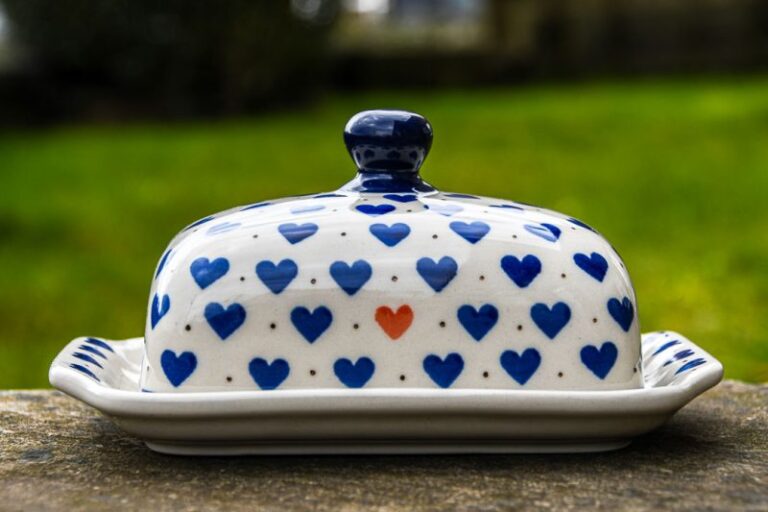Introduction
Ever seen something so simple yet so beautifully crafted that it instantly makes you smile? That’s the Door County Polish Butter Dish for you. It’s not just a butter dish—it’s a piece of art that connects tradition, functionality, and a sense of home. Hand-painted with bright, folk-inspired designs, this ceramic gem has found its way from quaint Polish workshops to cozy Door County kitchens, earning admiration from collectors and homemakers alike.
But what makes this dish so special? Is it the meticulous craftsmanship? The cultural symbolism? Or the way it turns an ordinary act—spreading butter on toast—into a small daily ritual of beauty? Let’s dive into the fascinating world of this remarkable creation and see why it’s turning heads far beyond Wisconsin’s peaceful shores.
The Origins of a Cultural Treasure
The Door County Polish Butter Dish didn’t appear out of thin air. Its roots go back to the heart of Poland, where traditional pottery—especially from the town of Bolesławiec—has been cherished for centuries. Polish artisans, using age-old techniques passed down through generations, mastered the art of creating durable, hand-painted ceramics with intricate blue-and-white motifs.
The Polish Craftsmanship Legacy
- Hand-Painted Precision: Each dish is decorated by hand using a unique “stamping” method involving tiny sponges dipped in vibrant glazes.
- Durability: Fired at extremely high temperatures, these pieces are chip-resistant and safe for the dishwasher or microwave.
- Signature Patterns: The trademark dots, florals, and folk-inspired swirls evoke a sense of nostalgia, tying modern-day users to centuries-old artistry.
When this traditional Polish pottery style found its way to Door County, Wisconsin, a region already known for its European charm, art galleries, and artisan shops, the match was simply meant to be.
Door County: Where Craft Meets Charm
A Midwestern Haven for Art Lovers
If you’ve ever wandered through Door County, you know it’s not your average Wisconsin getaway. It’s a place where art thrives, nature whispers, and creativity flows like cherry wine. Local potters, painters, and craftspeople often collaborate or take inspiration from European traditions—so it’s no surprise that Polish pottery became a natural fit here.
The Door County Polish Butter Dish embodies the county’s signature blend of rustic charm and artistic flair. It’s the perfect souvenir for visitors and a proud display piece for locals. Whether it’s perched on a farmhouse table or resting on a modern kitchen counter, it brings a story with it—a story that connects continents.
Why Everyone’s Talking About the Door County Polish Butter Dish
So, what’s behind the growing buzz around this quaint little butter dish? Sure, it’s beautiful. But it’s also practical, sentimental, and deeply personal.
The Emotional Connection
There’s something oddly comforting about objects that carry a touch of history. The Door County Polish Butter Dish feels familiar, like something your grandmother might have used, yet fresh enough to fit into a Pinterest-worthy kitchen.
The Artistic Appeal
Each dish is unique. The hand-painted dots and floral motifs vary slightly from piece to piece, meaning no two are ever exactly alike. That touch of imperfection adds to its charm—proof that a real person, not a machine, poured heart and skill into creating it.
The Practical Side
Let’s not forget—it’s still a butter dish. And it does its job well:
- Keeps butter fresh at room temperature
- Prevents spills or messes
- Doubles as a table decoration
- Easy to clean and maintain
Who knew something so small could pull so much weight in your kitchen décor?
The Symbolism Behind the Design
Polish pottery designs aren’t random; they’re steeped in symbolism and tradition. Every color, flower, and swirl holds meaning.
- Blue Dots: Represent harmony, peace, and connection—perfect for family gatherings.
- Floral Motifs: Symbolize life, fertility, and nature’s abundance.
- Geometric Patterns: Reflect balance and order, echoing the rhythm of Polish folk culture.
When these elements blend on the Door County Polish Butter Dish, they bring more than aesthetics—they bring good vibes, nostalgia, and a subtle touch of old-world magic.
From Poland to Door County: A Love Story of Cultures
Imagine artisans in Bolesławiec meticulously painting butter dishes, then seeing their creations travel thousands of miles to a small peninsula on Lake Michigan. It’s almost poetic. The Door County Polish Butter Dish stands as a testament to cultural exchange and the universality of beauty.
Door County’s boutique shops and galleries began importing and displaying Polish pottery decades ago, and the response was overwhelming. Locals and tourists alike fell in love with the craftsmanship. Over time, local potters started blending Polish-inspired techniques with Midwestern flair—creating hybrid designs that honored both traditions.
How to Choose the Perfect Door County Polish Butter Dish
Shopping for one? You’re in for a treat! But before you pick the first pretty pattern you see, consider these tips:
1. Look for Authenticity
Ensure it’s genuine Polish pottery—authentic pieces are stamped with a maker’s mark or origin seal.
2. Consider Your Kitchen Aesthetic
Love bold colors? Opt for dishes with vibrant reds and blues. Prefer something subtle? Go for classic navy-and-white patterns.
3. Check the Size
Some butter dishes are compact, perfect for single households, while others are roomy enough for a family block of butter.
4. Think Beyond Butter
Many people use these dishes for other things—like cheese, herbs, or even jewelry!
Caring for Your Polish Butter Dish
These pieces are tough cookies, but they still appreciate a little TLC.
- Dishwasher Safe: Yes—but handwashing will preserve the shine longer.
- Avoid Sudden Temperature Changes: Don’t move it straight from fridge to oven.
- Use Mild Detergents: Harsh chemicals can dull the glaze.
With proper care, your butter dish will last for decades—and maybe even become a family heirloom.
Why It Makes the Perfect Gift
Looking for something that’s both thoughtful and unique? The Door County Polish Butter Dish checks every box.
- Cultural Value: A story-rich item that bridges Polish tradition and American craftsmanship.
- Aesthetic Appeal: Eye-catching patterns fit every décor.
- Practical Utility: Useful in every kitchen—because who doesn’t love butter?
Perfect for weddings, housewarmings, or “just because” moments, this dish speaks the universal language of beauty and care.
The Growing Collector’s Market
Believe it or not, Polish pottery collecting is a full-blown passion for many. Some people have entire cabinets dedicated to these stunning ceramics. And the Door County Polish Butter Dish has quickly become a coveted piece.
Collectors look for:
- Limited-edition patterns
- Vintage or discontinued styles
- Signature artist markings
It’s not just décor—it’s an investment in craftsmanship and cultural preservation.
FAQs About the Door County Polish Butter Dish
Q1: Is the Door County Polish Butter Dish made in Poland or the U.S.?
Most authentic pieces originate in Poland, particularly in Bolesławiec, but some Door County artisans craft their own versions inspired by the Polish style.
Q2: Are all patterns hand-painted?
Yes! Each piece is individually painted using sponge-stamping and freehand techniques.
Q3: Can I use it in the microwave or dishwasher?
Absolutely. Genuine Polish pottery is both microwave- and dishwasher-safe.
Q4: What makes it different from regular butter dishes?
Its craftsmanship, cultural story, and one-of-a-kind artistry set it apart from mass-produced kitchenware.
Q5: Where can I buy one?
You can find them in Door County artisan shops, online Polish pottery boutiques, and specialty kitchenware stores.
Conclusion: More Than Just a Butter Dish
At the end of the day, the Door County Polish Butter Dish is more than a kitchen accessory—it’s a conversation starter, a piece of cultural heritage, and a symbol of creativity that transcends borders. Every brushstroke tells a story, every curve reflects dedication, and every pattern whispers a little bit of history.
It reminds us that beauty can live in everyday moments—in the gleam of morning butter, the chatter over breakfast, or the quiet pride of owning something handcrafted and meaningful. So next time you reach for butter, ask yourself: wouldn’t it be better coming from something with a soul?

